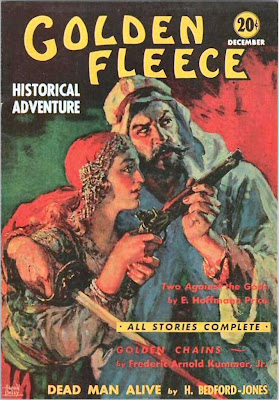There's more to Golden Fleece Historical Adventure than meets the eye. It ran for nine monthly issues from October 1938 to June 1939. True to its subtitle, the magazine printed stories of kings, Romans, pirates, knights, Vikings, cavaliers, and swashbucklers of every stripe. Thomas G.L. Cockcroft included Golden Fleece in his indexes of weird fiction magazines. I have never seen Golden Fleece and I'm not sure I have ever read any stories from it. I can't say how much weird fiction might be found in its pages. But I'll take Mr. Cockcroft's word for it and include Golden Fleece Historical Adventure in this series on weird fiction and fantasy magazines.
Golden Fleece began in the year that the Golden Age of Science Fiction is said to have commenced. Science fiction of course looks forward. By definition, historical fiction casts its gaze into the past. So why, at a time when science fiction was proliferating in the pulps and in popular culture in general, did Sun Publications of Chicago decide to publish a magazine against the trend? I don't have an answer, but that hasn't stopped me from speculating before.
When we think of pulps, we think of genres: science fiction, fantasy, Western, romance, detective, and so on. However, in the early years, individual pulp magazines included a mix of genres. The leading titles--Argosy, Adventure, Blue Book--were generalists: they printed adventure stories and romances of every kind. It looks to me like Golden Fleece was an attempt at that more generalized approach. The title--Golden Fleece--would have evoked the title Argosy. (1) After all, Jason, a hero of Greek myth, quests after the Golden Fleece aboard his ship, the Argo. The stories from his voyage comprise the first Argosy. The subtitle of Golden Fleece--Historical Adventure--is informative, but it, too, echoes the title of an earlier pulp magazine, Adventure. (2)
What else was going on at the time? World War II was brewing and all eyes were on the Old World and the historical forces that had shaped a continent. I'm not sure that's it, though. Here's a better explanation: Ron Goulart wrote a book about newspaper comics of the 1930s and called it The Adventurous Decade. But it wasn't just an adventurous ten years in the comics. The movies were pretty adventurous, too:
When we think of pulps, we think of genres: science fiction, fantasy, Western, romance, detective, and so on. However, in the early years, individual pulp magazines included a mix of genres. The leading titles--Argosy, Adventure, Blue Book--were generalists: they printed adventure stories and romances of every kind. It looks to me like Golden Fleece was an attempt at that more generalized approach. The title--Golden Fleece--would have evoked the title Argosy. (1) After all, Jason, a hero of Greek myth, quests after the Golden Fleece aboard his ship, the Argo. The stories from his voyage comprise the first Argosy. The subtitle of Golden Fleece--Historical Adventure--is informative, but it, too, echoes the title of an earlier pulp magazine, Adventure. (2)
What else was going on at the time? World War II was brewing and all eyes were on the Old World and the historical forces that had shaped a continent. I'm not sure that's it, though. Here's a better explanation: Ron Goulart wrote a book about newspaper comics of the 1930s and called it The Adventurous Decade. But it wasn't just an adventurous ten years in the comics. The movies were pretty adventurous, too:
- Moby Dick (1930)
- The Count of Monte Cristo (1934)
- The Scarlet Pimpernel (1934)
- Treasure Island (1934)
- Captain Blood (1935)
- The Lives of a Bengal Lancer (1935)
- Mutiny on the Bounty (1935)
- She (1935)
- The Three Musketeers (1935, filmed again in 1939)
- The Last of the Mohicans (1936)
- Captains Courageous (1937)
- King Solomon's Mines (1937)
- The Prince and the Pauper (1937)
- The Prisoner of Zenda (1937)
- The Adventures of Marco Polo (1938)
- The Adventures of Robin Hood (1938)
- The Buccaneer (1938)
- Beau Geste (1939)
- Gunga Din (1939)
- The Man in the Iron Mask (1939)
- Stanley and Livingstone (1939)
Most of the covers for Golden Fleece were painted by Harold S. De Lay. Margaret Brundage created the last cover. Both artists also contributed to Weird Tales. The names of authors published in Golden Fleece make a familiar list: H. Bedford-Jones, Anthony M. Rud, Robert E. Howard, E. Hoffman Price, Ralph Milne Farley, Murray Leinster, Victor Rousseau. The most prominent name on covers of the magazine who was not also published in Weird Tales was that of Talbot Mundy.
Golden Fleece Historical Adventure
Oct. 1938 to June 1939
9 Issues (Volumes 1 & 2)
Published by: Sun Publications, Chicago
Edited by: A.J. Gontier and C.G. Williams
Format: Pulp size (6-1/2 x 9-1/2 inches); 128 pages
Notes
(1) Argosy was still in print at the time. I won't go into the various name changes, but in one form or another Argosy was published from 1882 to 1978, a pretty astonishing run for an American magazine. Argosy was also the first pulp magazine.
(2) Adventure also had a long run, from 1910 to 1972. To round things out, Blue Book was in print from 1905 to 1975. Evidently the 1970s were a bad decade for old magazines.
(3) They were also the last decade in which the physical world was still mysterious to the vast majority of Americans. World War II, the Cold War, the end of empires, and other events would bring all that to an end. The events of this week show that Americans have grown weary of the world.
To be continued . . .
To be continued . . .
Updated on October 20, 2013.
Text and captions copyright 2013, 2023 Terence E. Hanley









Love and collect vigerously.
ReplyDelete